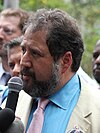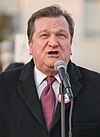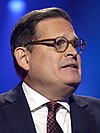The posts of shadow United States senator and shadow United States representative are held by elected or appointed government officials from subnational polities of the United States that lack congressional vote. While these officials are not seated in either chamber of Congress, they seek recognition for their subnational polity, up to full statehood. This would enfranchise them with full voting rights on the floor of the U.S. House and Senate, alongside existing states. As of 2021, only the District of Columbia and Puerto Rico currently have authorized shadow delegations to Congress.
This is distinct from shadow delegates, who are elected or appointed from subnational polities of the United States to seek non-voting participation in the House. As of 2024, only the Cherokee Nation and the United Keetoowah Band of Cherokee Indians elect shadow delegates.
History
Historically, shadow members of Congress were elected by organized incorporated territories prior to their admission to the Union. From its origins in Tennessee, this approach is sometimes known as the Tennessee Plan.
The first shadow senators, William Blount and William Cocke of the Southwest Territory, were elected in March 1796 before being seated as senators representing the newly formed state of Tennessee. Michigan, California, Minnesota, Oregon, and Alaska likewise elected shadow senators before statehood. The Alaska Territory also elected the first shadow U.S. representative, Ralph Julian Rivers, in 1956. All were eventually seated in Congress as voting members, except for Alaska shadow senator William A. Egan, who instead became governor.
| Territory | Office | Name | Elected | Seated |
|---|---|---|---|---|
| Southwest (now Tennessee) |
Senator | William Blount | Mar 28, 1796 | Dec 6, 1796 |
| Senator | William Cocke | |||
| Michigan | Senator | Lucius Lyon | Nov 10, 1835 | Jan 26, 1837 |
| Senator | John Norvell | |||
| California | Senator | William M. Gwin | Dec 20, 1849 | Sep 10, 1850 |
| Senator | John C. Frémont | |||
| Minnesota | Senator | James Shields | Dec 19, 1857 | May 12, 1858 |
| Oregon | Senator | Joseph Lane | Jul 5, 1858 | Feb 14, 1859 |
| Senator | Delazon Smith | |||
| Alaska | Senator | Ernest Gruening | Oct 6, 1956 | Jan 7, 1959 |
| Senator | William A. Egan | Elected governor in 1958 | ||
| Representative | Ralph J. Rivers | Jan 7, 1959 |
District of Columbia officeholders
The election of shadow congresspersons from the District of Columbia is authorized by a state constitution ratified by D.C. voters in 1982 but was never approved by Congress.
District of Columbia shadow senators
The voters of the District of Columbia elect two shadow U.S. senators who are known as senators by the District of Columbia but are not officially sworn in or seated by the U.S. Senate. Shadow U.S. senators were first elected in 1990.
The current shadow United States senators from the District of Columbia are Paul Strauss and Ankit Jain.
| Class 1Class 1 U.S. senators belong to the electoral cycle recently contested in 1994, 2000, 2006, 2012, 2018, and 2024. The next election will be in 2030. | C | Class 2Class 2 U.S. senators belong to the electoral cycle recently contested in 1996, 2002, 2008, 2014, and 2020. The next election will be in 2026. | ||||||||||
|---|---|---|---|---|---|---|---|---|---|---|---|---|
| # | Senator | Party | Dates in office | Electoral history | T | T | Electoral history | Dates in office | Party | Senator | # | |
| 1 | Florence Pendleton | Democratic | Jan 3, 1991 – Jan 3, 2007 |
Elected in 1990. | 1 | 102nd | 1 | Elected in 1990. Retired. |
Jan 3, 1991 – Jan 3, 1997 |
Democratic |  Jesse Jackson |
1 |
| 103rd | ||||||||||||
| Re-elected in 1994. | 2 | 104th | ||||||||||
| 105th | 2 | Elected in 1996. | Jan 3, 1997 – present |
Democratic |  Paul Strauss |
2 | ||||||
| 106th | ||||||||||||
| Re-elected in 2000. Was not re-nominated as a Democrat. Lost re-election bid as an independent. |
3 | 107th | ||||||||||
| 108th | 3 | Re-elected in 2002. | ||||||||||
| 109th | ||||||||||||
| 2 |  Mike Brown |
Democratic | Jan 3, 2007 – Jan 3, 2025 |
Elected in 2006. | 4 | 110th | ||||||
| 111th | 4 | Re-elected in 2008. | ||||||||||
| 112th | ||||||||||||
| Re-elected in 2012. | 5 | 113th | ||||||||||
| Independent | 114th | 5 | Re-elected in 2014. | |||||||||
| Democratic | 115th | |||||||||||
| Re-elected in 2018. Retiring at end of term. |
6 | 116th | ||||||||||
| 117th | 6 | Re-elected in 2020. | ||||||||||
| 118th | ||||||||||||
| 3 | Ankit Jain | Democratic | Jan 3, 2025 – present |
Elected in 2024. | 7 | 119th | ||||||
| # | Senator | Party | Years in office | Electoral history | T | C | T | Electoral history | Years in office | Party | Senator | # |
| Class 1 | Class 2 | |||||||||||
District of Columbia shadow representatives
The voters of the District of Columbia elect one shadow representative who is recognized as equivalent to U.S. representatives by the District of Columbia but is not recognized by the U.S. government as an actual member of the House of Representatives. A shadow representative was first elected in 1990. Inaugural office-holder Charles Moreland held the seat for two terms. In November 2020, Oye Owolewa was elected to succeed retiring shadow representative Franklin Garcia.
D.C.'s shadow U.S. representative should not be confused with the non-voting delegate who represents the district in Congress.
Puerto Rico officeholders
The posts of shadow representatives and senators for Puerto Rico were created in 2017 as part of a newly formed Puerto Rico Equality Commission to fulfill campaign promises made by the New Progressive Party, which gained control of both the executive and legislative branch in the 2016 elections in part with calls for a status referendum in 2017. Pro-statehood governor Ricardo Rosselló appointed five shadow representatives and two shadow senators with the advice and consent of the Senate of Puerto Rico.
Following the pro-statehood vote in the 2020 Puerto Rican status referendum, the Puerto Rican legislature passed in a lame duck session Law 167 of 2020, replacing the Puerto Rico Equality Commission with the new Commission to the Congressional Delegation of Puerto Rico and establishing an electoral process for shadow delegates to Congress. Although an effort to overturn Law 167 passed the House of Representatives of Puerto Rico in early 2021 after the Popular Democratic Party gained control of the legislature, it did not have enough votes to sustain a threatened veto from pro-statehood governor Pedro Pierluisi.
Popular elections for two shadow senators and four shadow members of Congress will be held on a nonpartisan basis every four years, with the first election held on May 16, 2021, so the delegates can take office on July 1. The law also appropriated funds for the Puerto Rico Federal Affairs Administration to cover the wages of the delegates and serve as their headquarters in Washington, D.C., where they will work on the statehood process with the island's resident commissioner in Congress.
Puerto Rico shadow senators
| Class The terms for Puerto Rico's shadow senators are not aligned with the classes of United States senators. |
C | Class The terms for Puerto Rico's shadow senators are not aligned with the classes of United States senators. | ||||||||||
|---|---|---|---|---|---|---|---|---|---|---|---|---|
| # | Senator | Party | Dates in office | Electoral history | T | T | Electoral history | Dates in office | Party | Senator | # | |
| 1 | Zoraida Fonalledas | New Progressive/ Republican |
Aug 15, 2017 – Jul 1, 2021 |
Appointed in 2017. Successor elected. |
1 | 115th | 1 | Appointed in 2017. Died. |
Aug 15, 2017 – May 2, 2021 |
New Progressive/ Democratic |
 Carlos Romero Barceló |
1 |
| 116th | ||||||||||||
| 117th | ||||||||||||
| — | May 2, 2021 – Jul 1, 2021 |
Vacant | ||||||||||
| 2 | Melinda Romero Donnelly | New Progressive/ Democratic |
July 1, 2021 – present | Elected in 2021. | 2 | 2 | Elected in 2021. | Jul 1, 2021 – present | New Progressive/ Republican |
 Zoraida Buxó |
2 | |
| 118th | ||||||||||||
| # | Senator | Party | Years in office | Electoral history | T | C | T | Electoral history | Years in office | Party | Senator | # |
| Class | Class | |||||||||||
Puerto Rico shadow representatives
| Years | Cong. | Shadow House members | |||||||||||||||||||||||||||||||||||||||||||||||
|---|---|---|---|---|---|---|---|---|---|---|---|---|---|---|---|---|---|---|---|---|---|---|---|---|---|---|---|---|---|---|---|---|---|---|---|---|---|---|---|---|---|---|---|---|---|---|---|---|---|
| Member | Party | Member | Party | Member | Party | Member | Party | Member | Party | ||||||||||||||||||||||||||||||||||||||||
| August 15, 2017 – January 6, 2018 |
115th |  Luis Fortuño |
New Progressive/ Republican |
 Charlie Rodríguez |
New Progressive/ Democratic |
 Iván Rodríguez |
Independent |  Pedro Rosselló |
New Progressive/ Democratic |
 Felix A. Santoni |
New Progressive/ Republican | ||||||||||||||||||||||||||||||||||||||
| January 6, 2018 – August 20, 2018 |
 Alfonso Aguilar |
New Progressive/ Republican | |||||||||||||||||||||||||||||||||||||||||||||||
| August 20, 2018 – July 22, 2019 |
 Luis Berríos-Amadeo |
Independent | |||||||||||||||||||||||||||||||||||||||||||||||
| July 22, 2019 – February 26, 2020 |
116th | Vacant | |||||||||||||||||||||||||||||||||||||||||||||||
| February 26, 2020 – July 1, 2021 |
Vacant | ||||||||||||||||||||||||||||||||||||||||||||||||
| 117th | |||||||||||||||||||||||||||||||||||||||||||||||||
| July 1, 2021 – June 26, 2023 |
Elizabeth Torres Rodriguez | New Progressive/ Republican |
 Ricardo Rosselló |
New Progressive/ Democratic |
Roberto Lefranc Fortuño | New Progressive/ Republican |
 María Meléndez |
New Progressive/ Democratic |
Seat eliminated | ||||||||||||||||||||||||||||||||||||||||
| 118th | |||||||||||||||||||||||||||||||||||||||||||||||||
| June 26, 2023 – July 17, 2023 |
Vacant | ||||||||||||||||||||||||||||||||||||||||||||||||
| July 17, 2023 – present |
Vacant | ||||||||||||||||||||||||||||||||||||||||||||||||
See also
- District of Columbia voting rights
- District of Columbia statehood movement
- Federal voting rights in Puerto Rico
- Statehood movement in Puerto Rico
- Non-voting members of the United States House of Representatives
References
- ^ Strauss, Paul. "A Brief History of the Shadow Senators of the United States". Paul Strauss – United States Senator for the District of Columbia. Archived from the original on February 11, 2003.
- "Puerto Rico's Tennessee Plan". American Action Forum. Retrieved March 10, 2019.
- Sheridan, Mary Beth (May 29, 2008). "D.C. Seeks to Fund Lobbying Effort for a Voting House Member". The Washington Post. p. B01. Retrieved December 29, 2008.
- Election profiles Michael D. Brown (D), The Washington Post, 2006, retrieved, September 30, 2012.
- Ley por la Igualdad y Representación Congresional de los Ciudadanos Americanos de Puerto Rico [Act for Equality and Congressional Representation of the United States Citizens of Puerto Rico] (PDF) (Act 40-2017) (in Spanish). June 5, 2017.
- Bernal, Rafael (August 15, 2017). "Puerto Rico swears in congressional delegation". The Hill. Washington, D.C.
- "Puerto Rico governor designates four members for Equality Commission". Caribbean Business. Guaynabo, Puerto Rico. July 3, 2017.
- "Ley Núm. 167 de 2020 -Ley para crear la Delegación Congresional de Puerto Rico". LexJuris Puerto Rico. Retrieved February 23, 2021.
- de Jesús Salamán, Adriana (January 29, 2021). "Peligra elección pro estadidad por falta de fondos y el PPD" [Statehood election in danger due to lack of funds and PPD]. NotiCel (in Spanish). San Juan, Puerto Rico. Retrieved February 24, 2021.
- Rivera Clemente, Yaritza (February 22, 2021). "Radicarán medida para atender el estatus" [They Will File a Measure to Amend the Status]. El Vocero (in Spanish). San Juan, Puerto Rico. Retrieved February 24, 2021.
- Padró Ocasio, Bianca; Ortiz-Blanes, Syra; Daugherty, Alex (January 28, 2021). "Puerto Rico governor plan for a 'shadow delegation' draws criticism amid pandemic". Miami Herald. Miami, Florida. Retrieved February 24, 2021.
- Ruiz Kuilan, Gloria (June 26, 2023). "Tribunal ordena la destitución de Elizabeth Torres como delegada congresional por la estadidad" [Court orders dismissal of Elizabeth Torres as congressional shadow delegate]. El Nuevo Día (in Spanish). Guaynabo, Puerto Rico. Retrieved June 29, 2023.
External links
- A Brief History of the Shadow Senators of the United States
- Washington Post article on shadow delegation
- Official Site of District of Columbia
- Shadow Congressional Representatives contact information
- Puerto Rico Equality Commission
- Puerto Rico Federal Affair Administration
| Washington, D.C. | |
|---|---|
| Topics | |
| Government | |
| Services | |
| Society | |
| History |
|
| Puerto Rico articles | |||||||||
|---|---|---|---|---|---|---|---|---|---|
| History |
| ||||||||
| Geography | |||||||||
| Ecology |
| ||||||||
| Politics | |||||||||
| Economy | |||||||||
| Society |
| ||||||||



